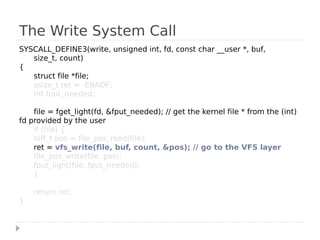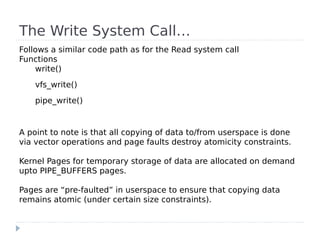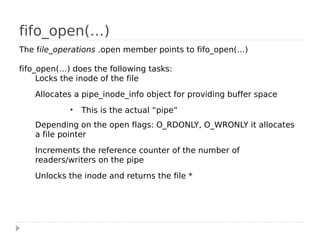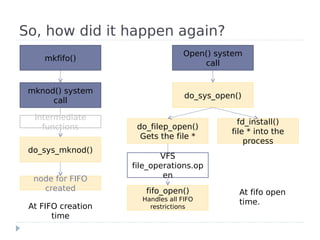The document discusses the Linux kernel's implementation of pipes, FIFOs, and its virtual filesystem structure. It explains the distinction between user space and kernel space, the role of virtual filesystems (VFS), and how system calls such as open, read, and write are handled in the kernel. Additionally, it details the mechanisms for managing inodes, directory entries, and file operations associated with pipe and FIFO functionalities.


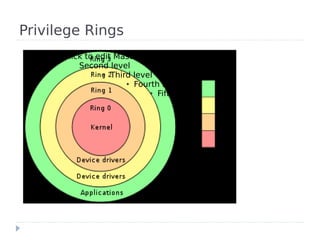


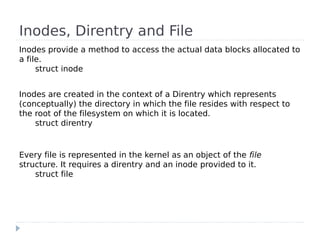


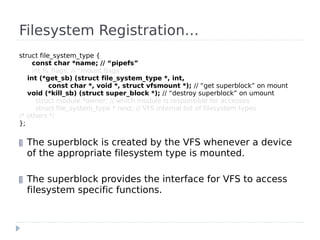
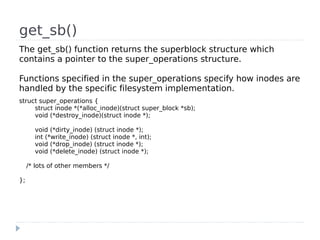
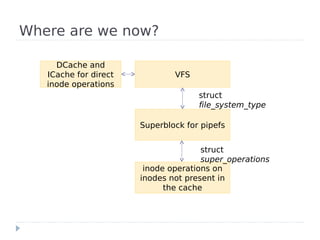
![The pipe() system call
SYSCALL_DEFINE2(pipe2, int __user *, fildes, int, flags)
{
int fd[2];
int error;
error = do_pipe_flags(fd, flags); // Handle flags, create a file *
representing the pipe
if (!error) {
if (copy_to_user(fildes, fd, sizeof(fd))) { // copy to
userspace
sys_close(fd[0]); // if error – close and exit.
sys_close(fd[1]);
error = -EFAULT;
}
}
return error;
}](https://image.slidesharecdn.com/linuxkernelimplementationofpipesfifos-110729170648-phpapp02/85/The-Linux-Kernel-Implementation-of-Pipes-and-FIFOs-12-320.jpg)
![The pipe() system call…
Creates a directory entry
Creates an inode
Creates a file
Associates the directory entry and the inode with it
Creates 2 file * by opening it with O_RDONLY and O_WRONLY flags
It associates a file_operations structure with each descriptor
depending on the operations expected to be performed on it.
Installs the file *s in the file descriptor table of the process and
generates 2 file descriptors (of type int)
Returns the file descriptors in the fd[2] array.](https://image.slidesharecdn.com/linuxkernelimplementationofpipesfifos-110729170648-phpapp02/85/The-Linux-Kernel-Implementation-of-Pipes-and-FIFOs-13-320.jpg)

![The pipe() system call…
The file created to represent the pipe is backed by buffers managed by
a pipe_inode_info object.
struct pipe_inode_info { // shown partially… : represents the pipe
wait_queue_head_t wait; // waiting queue for blocked writers
unsigned int readers;
unsigned int writers;
unsigned int waiting_writers;
struct inode *inode;
struct pipe_buffer bufs[PIPE_BUFFERS]; // backing data store – points to
actual pages.
};
PIPE_BUFFERS == 16
Atomicity guarantees:
PIPE_BUF is the maximum limit which is guaranteed for atomic
operations. PIPE_BUF = PAGE_SIZE (4096)
Atomicity is lost on page faults.](https://image.slidesharecdn.com/linuxkernelimplementationofpipesfifos-110729170648-phpapp02/85/The-Linux-Kernel-Implementation-of-Pipes-and-FIFOs-15-320.jpg)
![So, where are we?
User calls
pipe(fd[2])
VFS
do_pipe() in kernel
Install file
Creates pipefs file created on
descriptors in the
pipefs.
process
Pipe_inode_info
buf[16]
At initialization
time
Page 1 Page 2 Page 3 …
At syscall time](https://image.slidesharecdn.com/linuxkernelimplementationofpipesfifos-110729170648-phpapp02/85/The-Linux-Kernel-Implementation-of-Pipes-and-FIFOs-16-320.jpg)


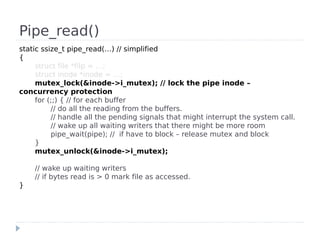

![So where are we?
Read() system call
vfs_read()
Intermediate
functions
pipe_read() Schedule()
Pipe_inode_info
buf[16]
Access controlled
by the inode
Page 1 Page 2 Page 3 …
mutex](https://image.slidesharecdn.com/linuxkernelimplementationofpipesfifos-110729170648-phpapp02/85/The-Linux-Kernel-Implementation-of-Pipes-and-FIFOs-21-320.jpg)
